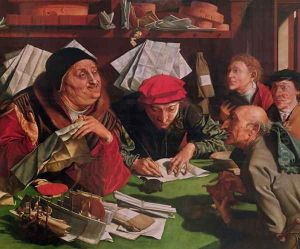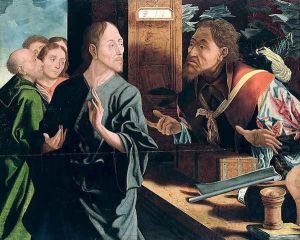Marinus van Roymerswaele Paintings
Marinus van Roymerswaele was a notable Dutch Renaissance painter, born around 1490 in the town of Reimerswaal, from which he derives his name. Van Roymerswaele is primarily known for his detailed and vivid depiction of tax collectors, money changers, and lawyers, offering a unique window into the financial and legal professions of the 16th century. His works are characterized by their meticulous attention to detail, vibrant colors, and the satirical portrayal of his subjects, often highlighting the greed and corruption associated with money handlers of his time.
Van Roymerswaele's early life and training are not thoroughly documented, but it is believed that he may have been a pupil of Quentin Matsys, a prominent Antwerp painter known for similar subject matter. This connection is suggested through the stylistic similarities between their works, particularly in the portrayal of figures and the treatment of textures and fabrics. Marinus was officially registered as a master in the Guild of St. Luke in Antwerp in 1527, which marked the beginning of his professional career as an artist.
Throughout his career, van Roymerswaele received numerous commissions from local patrons as well as from abroad, indicating his fame and the high demand for his works. His paintings were not only appreciated for their artistic quality but also for their commentary on societal issues. Some of his most famous works include 'The Tax Collectors', 'The Money Changer and His Wife', and 'The Lawyer's Office'. These paintings showcase his ability to combine technical skill with a keen observation of human nature and societal critique.
Marinus van Roymerswaele's contribution to Northern Renaissance art is significant, particularly in his exploration of genre scenes that provide insight into 16th-century life. His portrayal of everyday subjects with a moralistic and sometimes humorous lens set him apart from his contemporaries. Van Roymerswaele died in 1567, but his legacy endures through his influential works, which continue to be studied and admired for their artistic and historical value. His paintings reside in several prestigious museums around the world, serving as a testament to his enduring appeal and significance in the history of art.

